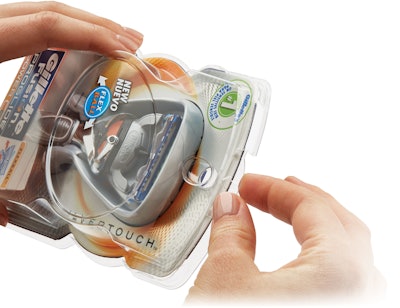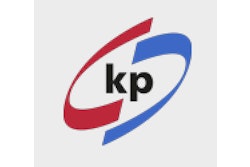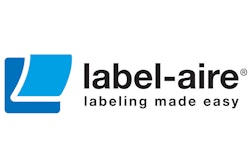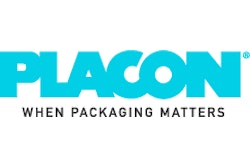When it comes to deciding what a CPG company’s packaging should look like and cost, it must be tempting for the decision makers to settle into a comfort zone of sorts, a place where well known, predictable, and approved vendors can efficiently supply materials whose chief virtue is that they probably won’t disappoint.
So credit should be given to the packaging developers behind Procter & Gamble’s Gillette Brand, where engaging new packaging technologies—whether they come from entirely new vendors or suppliers that have served for decades—seems to be the standard operating procedure. In this kind of environment, real packaging innovation flourishes.
The latest breakthroughs have a kind of Venus and Mars quality to them in that one is a razor for women and one is a razor for men. But that’s pretty much where the similarities end. Let’s begin with Mars: Gillette Fusion ProGlide Flex Ball shavers for men.
The package consists of tray with label, paperboard insert, and thermoformed PET blister with two labels. Be Green Packaging makes the molded pulp tray out of renewable bamboo and bulrush fiber-based material. Gillette was a trailblazer in the use of this material, which scores serious sustainable packaging points because it’s made from such a readily renewable resource. As for the paperboard insert, that’s what carries much of the graphic pop.
But it’s the clear thermoformed PET blister, made by Placon, that is most intriguing. Placon uses matched metal tooling to create a perforation around the entire perimeter of the blister, which is heat-sealed to the paperboard insert. Custom tooling deployed by Placon also creates a pull tab marked with an arrow at the very top of the package. So the consumer intuitively knows that he should pull this tab to access the package contents. When he does, the PET blister separates along the perf and the top comes off as smooth as can be.
A closer look
Now for some details—first on the thermoforming and then on how the packaging is done. This thermoform is described as “multi-level,” which can be seen by looking at the left top side of the flange. As the eye follows around the corner and reaches the pull tab it becomes clear that this tab is not on the same plane as the rest of the flange. That’s what makes it multi-level.
In making this thermoform, Placon first forms the sheet and then moves it to a trim station to make the perforation that gives the package its easy-open functionality. Then the sheet is moved to a second trim station to trim out the finished part.
“This is not an easy part to make,” says Gillette’s Jim Meech, Senior Development Engineer, PackDev/Global Blades & Razors. “Even cutting it out of its sheet is complicated because of its multilevel format.”
In a completely separate operation, Placon also applies two pressure-sensitive film labels to the thermoform. This is accomplished by two Labelaire labelers that are integrated into a custom piece of handling equipment. Getting the “New/Nuevo Flex Ball” label into the recessed oval is challenging. Flexo printed in eight colors, the BOPP labels are supplied by CCL.
Placon ships the thermoforms to a Gillette plant for packaging on a Sencorp machine that operates in a linear fashion. Essentially it’s a two-lane, intermittent-motion machine. Down Lane One run cavities arranged in metal plates in a two-across and four-in-the-machine-direction pattern. So it’s eight cavities per metal plate. The molded pulp trays are picked and placed automatically eight per stroke into these cavities. In a second pick-and-place station, a fan-folded instruction booklet is placed into each molded pulp tray. Then eight razors, each in its gray plastic carrier, are placed inside eight trays.
Lane Two
Parallel to Lane One and stroking forward right alongside it is Lane Two, which also consists of metal carrier plates each having eight cavities arranged two-across and four in the machine direction. The Sencorp machine picks eight of the printed paperboard cards from magazine feeds and places them in the cavities of Lane Two. Next, eight PET blisters are picked by vacuum suction cups and placed on top of the eight paperboard cards. Heat-seal tooling comes up beneath the eight cards while from above a matching eight-cavity anvil presses down on the flange of the PET blister. Because the top decorated surface of the paperboard cards is coated with a heat-seal coating, the paperboard adheres to the PET blister. Now Lane Two indexes again and a pick head with suction cups picks eight blisters, each one with its heat-sealed paperboard card, and positions them above eight blue trays holding freshly inserted razors. Glue is applied to the flange of eight blue trays and then the eight PET blisters come down onto the trays so that the paperboard gets glued to the blue tray flange.
At this point the finished trays are offloaded onto an accumulation tower supplied by Sencorp White. It’s equipped with mechanical fingers that continuously press down on the package flanges so that the glue bond between the paperboard and the flange of the molded pulp tray can set up properly during the two minutes the packages spend in this tower.
There was one recycling gain Gillette made by replacing flexible film lidding material with the PET blister and paperboard card combo. When the flexible film was applied as a lid, the molded fiber tray had to have a layer of low-density polyethylene laminated to it so that the flexible film lidding would adhere. Since adding flexible film lidding is no longer part of the packaging process, BeGreen no longer laminates the LDPE layer to the trays. Consequently, a purer paper free of LDPE is what goes into the paper recycle stream.
On to Venus
We turn now to the Venus Swirl. Packaging consists of a thermoformed GPETG blister holding a thermoformed PET insert tray that holds one razor and two cartridges. Heat sealed to this blister is a thermoformed GPETG lid. Also placed in the bottom of the clear blister is a paperboard insert with product information.
The single most salient feature of this new ladies razor is its FLEXIBALL technology, a rotating hinge of sorts that permits the user to reach tricky areas for a flawless shave. The Gillette team decided that the packaging must showcase this silver ball, so in essence they reproduced it in 3D on the thermoformed GPETG lid. They accomplished this through exclusive technology developed by think4D, which produces the thermoformed lid in two steps. First is decorating and laminating on a 10-station flexo system. The substrate that gets decorated with UV-curable inks is a multilayer coextrusion from Klöckner Pentaplast that has PET at the center surrounded by skin layers of glycol-modified PET. The use of this material, which Klöckner calls GPETG, is what makes it possible to heat-seal the thermoformed lid to the clear PET blister, which is also made from Klöckner’s GPETG.
Also worth pointing out is that in one of the 10 stations on think4D’s decorating system, a cast and cure process gives the lid its holographic effects. In another station, the silver metallic FLEXIBALL effect is applied at a cold-foil stamping station. And in yet another station, a clear PET film is adhesive laminated over the decorated substrate to prevent the inks and foil stamping from getting damaged when it comes time to heat seal the lid to the blister. Also, something that think4D refers to as “hybrid AM & FM screening” provides the soft graduated screens and details in the highlights.
With decoration finished, the decorated substrate is then rewound and, in a second process, is formed in register with the decoration on what think4D President Mike Fehr calls “thermoforming-like equipment that we developed in partnership with a machine builder.” Coming out of this process are finished, die-cut parts. The ability to thermoform in register with the silver decoration used to create the silver ball is something that, says think4D, only they can do. Equally notable about the silver ball is the cold-foil stamping, which has to be pretty special to not crack as it’s thermoformed to a depth of about 4 mm.
Silver swivel
“With this product it’s all about the silver swivel on the handle,” says Andrew Dominesey, Section Head, B&R Americas, Grooming PackDev. “We wanted the package to draw attention to that.” So why not put a round circle of silver ink on a heat sealed flexible film lidding material and be done with it? Was thermoforming really necessary? “I think this has much more impact, especially with that nice mirror finish on the silver ball. It has that stop, hold, and close quality that we look for in packaging.”
Incorporating this disruptive packaging technology required careful planning and execution, says Gillette. Especially challenging from a production standpoint is that on the customized Sencorp heat-sealing machine on which this product is packaged, the 3D lids have to be heat-sealed to a thermoformed blister that has an arched surface.
“We have this arched surface to deal with in other Venus packages, but there the lidding material being sealed is a flexible film,” says Dominesey. “Here it’s a thermoformed piece. Our packaging engineers had their work cut out for them in making the production process repeatable and capable of being done at good production rates.”
One thing that helps considerably is the innovative pack-out system developed by think4D. The lids are packed hot right off the thermoforming line in a way that takes advantage of residual heat to maintain the desired arch. “The lids are stacked in a special configuration so that they remain arched enough to lie nicely on top of the blisters when they are picked and placed on them,” says Dominesey.
Easily overlooked in all the excitement surrounding the lid is that the clear blister thermoformed by Placon incorporates a clever easy-open feature modeled after a cigarette pack. By placing her finger into a molded opening in the blister and pulling, the consumer can easily tear the short lines of perforations on either side of the fingertip opening. This opens the package on three sides so that the consumer can bend the top of the blister back on itself and slide the contents out of the package.



























